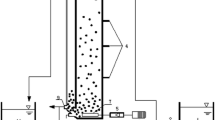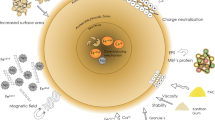Abstract
Aerobic granulation is a promising technology for wastewater treatment, but problems regarding its formation and stability need to be solved. Divalent metal ions, especially Ca2+, Mg2+ and Mn2+, have been demonstrated to play an important role in the process of aerobic granulation. Here, we studied whether iron ions can affect aerobic granulation. Granular sludge formed without iron ion addition (<0.02 mg Fe2+ L−1) was fluffy and had a finger-type structure and filamentous out-growth. The addition of iron ions to concentrations of 1 and 10 mg Fe2+ L−1 repressed the finger-type structure and filamentous out-growth. The results show that chemical precipitation in the granules with iron ion addition was higher than that in the granules without ferrous addition. The amount of precipitates was higher inside the granules than outside. This study demonstrates that iron ions (Fe2+/Fe3+) increase the size and stability of aerobic granular sludge but do not affect the granulation time, which is the time that the first granular sludge is observed. The study shows that aerobic granular sludge technology can be confidently applied to actual wastewater containing a high concentration of iron compounds.






Similar content being viewed by others
References
APHA–AWWA–WPCF (1995) Standard methods for the examination of water and wastewater. American Public Health Association/American Water Works Association/Water Environment Federation, Washington, DC
Banu JR, Do KU, Yeom IT (2008) Effect of ferrous sulphate on nitrification during simultaneous phosphorus removal from domestic wastewater using a laboratory scale anoxic/oxic reactor. World J Microbiol Biotechnol 2:2981–2986
Burgess JE, Quarmby J, Stephenson T (1999) Role of micronutrients in activated sludge-based biotreatment of industrial effluents. Biotechnol Adv 17:49–70
Caudan C, Filali A, Lefebvre D, Spérandio M, Girbal-Neuhauser E (2012) Extracellular polymeric substances (EPS) from aerobic granular sludges: extraction, fractionation, and anionic properties. Appl Biochem Biotechnol 166:1685–1702
Caudan C, Filali A, Spérandio M, Girbal-Neuhauser E (2014) Multiple EPS interactions involved in the cohesion and structure of aerobic granules. Chemosphere 117:262–270
Choi HJ, Choi CH, Lee SM (2009) Analyses of phosphorus in sewage by fraction method. J Hazard Mater 167:345–350
de Haas D, Wentzel MC, Ekama GA (2000) The use of simultaneous chemical precipitation in modified activated sludge systems exhibiting biological excess phosphate removal part 2: method development for fractionation of phosphate compounds in activated sludge. Water SA 26(4):453–465
de Kreuk MK, van Loosdrecht MCM (2004) Selection of slow growing organisms as a means for improving aerobic granular sludge stability. Water Sci Technol 49(11–12):9–17
de Kreuk MK, van Loosdrecht MCM (2006) Formation of aerobic granules with domestic sewage. J Environ Eng 132:694–697
de Kreuk MK, Kishida N, Tsuneda S, van Loosdrecht MCM (2010) Behavior of polymeric substrates in an aerobic granular sludge system. Water Res 44:5929–5938
Hao W, Li Y, Lv J, Chen L, Zhu J (2016) The biological effect of metal ions on the granulation of aerobic granular activated sludge. J Environ Sci 44:252–259
Huang L, Yang T, Wang W, Zhang B, Sun Y (2012) Effect of Mn2+ augmentation on reinforcing aerobic sludge granulation in a sequencing batch reactor. Appl Microbiol Biotechnol 93:2615–2623
Huang W, Wenlong W, Wansheng S, Lei Z, Zhang Z, Chen R, Zhou B (2014) Use low direct current electric field to augment nitrification and structural stability of aerobic granular sludge when treating low COD/NH4-N wastewater. Bioresour Technol 171:139–144
Huang W, Huang W, Li H, Lei Z, Zhang Z, Tay JH et al (2015) Species and distribution of inorganic and organic phosphorus in enhanced phosphorus removal aerobic granular sludge. Bioresour Technol 193:549–552
Jenkins D, Richard MG, Daigger GT (2004) Manual on the causes and control of activated sludge bulking, foaming, and other solids separation problems. Lewis Publishers, London
Jiang HL, Tay JH, Liu Y, Tay STL (2003) Ca2+ augmentation for enhancement of aerobically grown microbial granules in sludge blanket reactors. Biotechnol Lett 25(2):95–99
Juang YC, Adav SS, Lee DJ, Tay JH (2010) Stable aerobic granules for continuous-flow reactors: precipitating calcium and iron salts in granular interiors. Bioresour Technol 101:8051–8057
Kampschreur MJ, Kleerebezem R, de Vet WWJM, van Loosdrecht MCM (2011) Reduced iron induced nitric oxide and nitrous oxide emission. Water Res 45:5945–5952
Kończak B, Karcz J, Miksch K (2014) Influence of calcium, magnesium, and iron ions on aerobic granulation. Appl Biochem Biotechnol 174:2910–2918
Kong Q, Ngo HH, Shu L, Fu R, Jiang C, Miao M (2014) Enhancement of aerobic granulation by zero-valent iron in sequencing batch airlift reactor. J Hazard Mater 279:511–517
Lemaire R, Webb RI, Yuan Z (2008) Micro-scale observations of the structure of aerobic microbial granules used for the treatment of nutrient-rich industrial wastewater. ISME J 2:528–541
Li XM, Liu QQ, Yang Q, Guo L, Zeng GM, Hu JM et al (2009) Enhanced aerobic sludge granulation in sequencing batch reactor by Mg2+ augmentation. Bioresour Technol 100:64–67
Lin Y, de Kreuk MK, van Loosdrecht MCM, Adin A (2010) Characterization of alginate-like exopolysaccharides isolated from aerobic granular sludge in pilot-plant. Water Res 44:3355–3364
Liu Y, Liu QS (2006) Causes and control of filamentous growth in aerobic granular sludge sequencing batch reactors. Biotechnol Adv 24(1):115–127
Liu Y, Tay JH (2004) State of the art of biogranulation technology for wastewater treatment. Biotechnol Advances 22(7):533–563
Liu Y, Yang SF, Tay JH (2004) Improved stability of aerobic granules by selecting slow-growing nitrifying bacteria. J Biotechnol 108:161–169
Liu L, Gao DW, Zhang M, Fu Y (2010) Comparison of Ca2+ and Mg2+ enhancing aerobic granulation in SBR. J Hazard Mater 181:382–387
Liu Y, Shi H, Li W, Hou Y, He M (2011) Inhibition of chemical dose in biological phosphorus and nitrogen removal in simultaneous chemical precipitation for phosphorus removal. Bioresour Technol 102:4008–4012
Liu Y, Liu Z, Wang F, Chen Y, Kuschk P, Wang X (2014) Regulation of aerobic granular sludge reformation after granular sludge broken: effect of poly aluminium chloride (PAC). Bioresour Technol 158:201–208
McSwain BS, Irvine RL, Hausner M (2005) Composition and distribution of extracellular polymeric substances in aerobic flocs and granular sludge. Appl Environ Microbiol 71(2):1051–1057
Oikonomidis I, Burrows LJ, Carliell-Marquet CM (2010) Mode of action of ferric and ferrous iron salts in activated sludge. J Chem Technol Biotechnol 85(8):1067–1076
Philips S, Rabaey K, Verstraete W (2003) Impact of iron salts on activated sludge and interaction with nitrite or nitrate. Bioresour Technol 88:229–239
Pronk M, Abbas B, Al-Zuhairy SH, Kraan R, Kleerebezem R, van Loosdrecht MCM (2015) Effect and behaviour of different substrates in relation to the formation of aerobic granular sludge. Appl Microbiol Biotechnol 99(12):5257–5268
Ren TT, Liu L, Sheng GP, Liu XW, Yu HQ, Zhang M-C, Zhu J-R (2008) Calcium spatial distribution in aerobic granules and its effect on structure, strength and bioactivity. Water Res 42:3343–3352
Sajjad M, Kim KS (2015) Studies on the interactions of Ca2+ and Mg2+ with EPS and their role in determining the physicochemical characteristics of granular sludge in SBR system. Process Biochem 50:966–972
Show KY, Lee DJ, Tay JH (2012) Aerobic granulation: advances and challenges. Appl Biochem Biotechol 167:1622–1640
Stobeck DC, Higgins MJ (2002) Examination of three theories for mechanisms of cation-induced bioflocculation. Water Res 36(3):527–538
Straub KL, Benz M, Schink B, Widdel F (1996) Anaerobic, nitrate-dependent microbial oxidation of ferrous iron. App Environ Microbiol 62(4):1458–1460
Tai YL, Dempsey BA (2009) Nitrite reduction with hydrous ferric oxide and Fe(II): stoichiometry, rate, and mechanism. Water Res 43:546–552
Tay JH, Liu Y (2001) Microscopic observation of aerobic granulation in sequential aerobic sludge blanket reactor. J Appl Microbiol 91(1):168–175
Wang XH, Diao MH, Yang Y, Shi YJ, Gao MM et al (2012) Enhanced aerobic nitrifying granulation by static magnetic field. Bioresour Technol 110:105–110
Wang R, Peng Y, Cheng Z, Ren N (2014a) Understanding the role of extracellular polymeric substances in an enhanced biological phosphorus removal granular sludge system. Bioresour Technol 169:307–312
Wang Z, Gao M, Wang S, Xin Y, Ma D, She Z et al (2014b) Effect of hexavalent chromium on extracellular polymeric substances of granular sludge from an aerobic granular sequencing batch reactor. Chem Eng J 251:165–174
Wei X, Vajrala N, Hauser L, Sayavedra-Soto LA, Arp DJ (2006) Iron nutrition and physiological responses to iron stress in Nitrosomonas europaea. Arch Microbiol 186:107–118
Yilmaz G, Lemaire R, Keller J, Yuan Z (2008) Simultaneous nitrification, denitrification and phosphorus removal from nutrient-rich industrial wastewater using granular sludge. Biotechnol Bioeng 100:529–541
Zhang HL, Wang YP, Sheng GP, Xia CW, Zeng RJ et al (2013) Species of phosphorus in the extracellular polymeric substances of EBPR sludge. Bioresour Technol 142:714–718
Acknowledgments
This work was funded by The Scientific and Technological Research Council of Turkey, TUBITAK (Project Number = 107Y137).
Author information
Authors and Affiliations
Corresponding author
Electronic supplementary material
Below is the link to the electronic supplementary material.
Rights and permissions
About this article
Cite this article
Yilmaz, G., Bozkurt, U. & Magden, K.A. Effect of iron ions (Fe2+, Fe3+) on the formation and structure of aerobic granular sludge. Biodegradation 28, 53–68 (2017). https://doi.org/10.1007/s10532-016-9777-2
Received:
Accepted:
Published:
Issue Date:
DOI: https://doi.org/10.1007/s10532-016-9777-2




